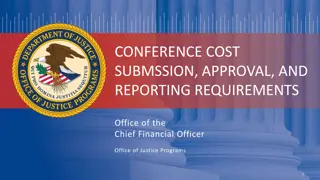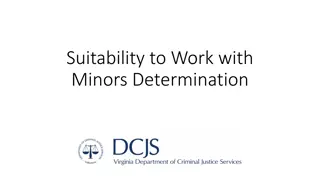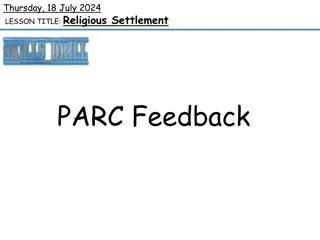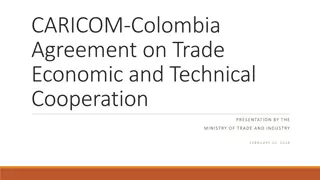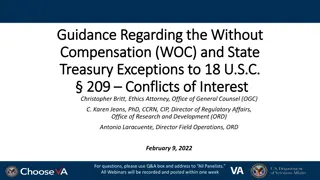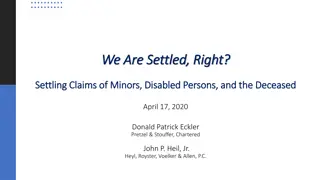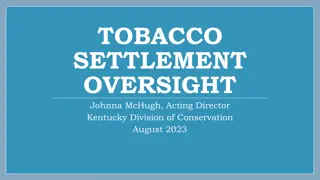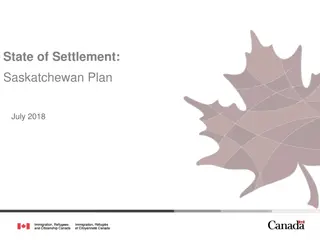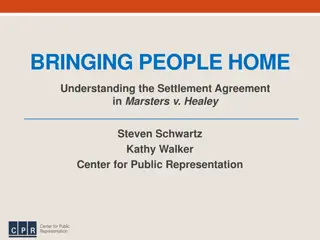
Overview of DOJ Settlement Agreement Process
"Learn about the progression and key components of the DOJ settlement agreement starting from the initial investigations in 2008 to the focus on case management and individual and family support programs. Explore the population targeted, waiver slots required, and the critical role of case management in achieving the agreement's outcomes."
Download Presentation

Please find below an Image/Link to download the presentation.
The content on the website is provided AS IS for your information and personal use only. It may not be sold, licensed, or shared on other websites without obtaining consent from the author. If you encounter any issues during the download, it is possible that the publisher has removed the file from their server.
You are allowed to download the files provided on this website for personal or commercial use, subject to the condition that they are used lawfully. All files are the property of their respective owners.
The content on the website is provided AS IS for your information and personal use only. It may not be sold, licensed, or shared on other websites without obtaining consent from the author.
E N D
Presentation Transcript
DOJ SETTLEMENT AGREEMENT AN OVERVIEW
IN THE BEGINNING 2008 DOJ started investigations at CVTC Under Civil Rights of Institutionalized Persons Act 2010 - Broadened investigation to all training centers and community supports and services under ADA and Olmstead 2011- DOJ issued findings 2011- DBHDS entered into negotiations with Department of Justice 1/26/2012 DBHDS and DOJ entered a Settlement Agreement Consent Decree signed 8/2012 following opportunity of stakeholders opportunity to file Amicus Briefs and letters highlighting Pros and Cons of SA
SECTION III: THE SETTLEMENT AGREEMENT POPULATION Currently reside at any of the training centers, Meet the criteria for the Intellectual Disability (ID) waiver or Developmental Disability (DD) waiver wait lists, Currently reside in a nursing home or ICF.
SECTION III: WAIVER SLOTS REQUIRED BY DOJ APPROVED THROUGH GA
SECTION III: CASE MANAGEMENT Critical role in achieving the intention and outcomes of the SA SA focus on collaboration, comprehensive ISP development, meeting needs, monitoring, and assuring choice Established a single point of entry for Developmental Disability Case Management (CM) with Waiver redesign (2016) Increased focus on CM Established a Case Management Steering Committee (2018) Funded a CM System Study (2018) Enhanced CM Training Modules (2019) Created an online DD CM Manual (2019) Funded a Transactional CM pilot (2019) Established an electronic data exchange for centralized ISPs (2019) Implemented a Support Coordination Quality Review process (2019) Implemented standardized assessments for crisis risk, health risks, changes in status, and appropriate service implementation (2020)
SECTION III: CRISIS SERVICES BRIEF HISTORY WHAT REACH PROVIDES A 24/7 mobile crisis response Developed to address need of supporting individuals with a developmental disability through crisis events in the community Crisis line 24/7 face to face response Community-based mobile crisis services Implementation of crisis stabilization plans in the natural setting Development of a Crisis Education and Prevention Plan (CEPP) Adult programs began in FY12, short term residential launched FY16 Coaching/Mentoring the system of support Prevention services & linkages Crisis Therapeutic Home Residential crisis stabilization for up to 10 days for children, 30 days for adults Step down transition from hospitals, jail, training center Child programs began FY16, short term residential launched FY20 Prevention stays to add additional support during periods of high stress
SECTION III: EMPLOYMENT/INTEGRATED DAY EMPLOYMENT FIRST INITIATIVE PROCLAMATION OCTOBER 2011 EMPLOYMENT FIRST POLICY DECEMBER 2012
SECTION III: REGIONAL SUPPORT TEAMS Five Regional Support Teams were developed in 2013 with a focus on supporting people in the most integrated setting consistent with their informed choice and needs Reviews referrals for people with DD in the target population when established criteria are met Difficulty finding services Considering a congregate setting of five or more people Considering a nursing home or ICF-IID Pattern of being removed from home Diverse stakeholder and professional membership Seeks to resolve barriers to more integrated settings Makes recommendations to SCs/planning teams Contributes data related to gaps in services
SECTION IV: DISCHARGE PLANNING AND TRAINING CENTERS A Community Integration Manager was placed at each Training Center to provide support and direction for transition/discharge operations and coordinate the implementation of policies, procedures, regulations, and other initiatives related to ensuring individuals residing in Training Centers are served in the most integrated setting appropriate to their needs and desires. The implementation of a 12 Week Discharge Process that includes collaboration between all support partners to establish essential supports and identify viable, more integrated options for residential care, day activity services and employment. Development of a robust post move monitoring process completed by Training Center staff, the Community Services Board and Office of Human Rights to ensure the provision of essential supports following discharge Incident Review Follow Up process to track and trend serious incidents and offer additional support to community providers as needed to ensure the health, safety and wellbeing of individuals discharged from Training Centers
SECTION V: QUALITY AND RISK MANAGEMENT Quality and Risk Management Create Quality and Risk Management System Leveraged work from Licensing Focus on Risk Mitigation Risk Triggers and Thresholds Incident Reporting Corrective Action Plans Created Division of Quality Focus on Quality Improvement Quality Improvement Committee Regional Quality Councils Data Reliability and Validity including gap Analysis Quality Service Reviews
KEY ACCOMPLISHMENTS 1. Completely redesigned the waivers-(created new waivers that met peoples needs, redesigned the waiting list, created new services that did not previously exist, and did this all in a fiscally responsible way (rate study)) 2. Developed a crisis system for individuals with DD 3. Improved data and reports 4. Have provided over 5,000 new waivers to people 5. Closed 4 training centers 6. Created a new waiver management system 7. Created an IFSP program 8. Created a quality system where one did not previously exist 9. Created an incident management unit where one did not previously exist 10. Improved consistency in the way licensing reviews were complete 11. Created Jump Start funding for provider to initiate new services 12. Developed new providers for specialty care 13. Developed Office of Integrated Health/DD Health Support Network
BIG PICTURE VIEW PROJECT MANAGEMENT Avoiding Crises Choice and Self-Determ- ination Safety/Freedom from harm Provider Capacity Access to Services Physical, Mental Behavioral Community Inclusion Physical, mental, behavioral health and well-being Health/Well-being Goals (KPAs) Safety/ Freedom From Harm Stability Avoiding Crises Health, Safety Provider Competency Community Integration and Wellbeing and Capacity and Inclusion Drivers CMS Requirements, Regulations Case Integrated Settings Employment Transpor- tation Community Living Provider Partnership Licensing Incident Reporting Corrective Actions Inspections Investiga- tions Communi- cations/ Training CSB Other Pro- viders Supervisor Family Outreach DOJ Library Crisis Management Performance Standards RSTs Management Performance Standards Business areas Measures QM/RM
DEPARTMENT OF JUSTICE (DOJ) SETTLEMENT AGREEMENT Build the Run Completing the Build Summaries to document compliance Operationalize what was built Performance Management Dashboard Show progress against the measures (quantitative compliance indicators) Demonstrate successful surveillance (qualitative compliance indicators) Data Management Data as a controlled asset Sustainability Backlog Build out the mid-to-long-term solutions to replace minimum viable product Heavily reliant on Phase 1 data gap analysis and process opportunities from Build the Run Public Launch Document Library Shows evidence of compliance Updated over time to ensure ongoing compliance




